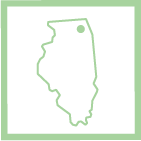
Deer Park,IL,USA
One could say that the suburbs of an American midwestern town mirrors that of a Levittown model of uniformity, the homestead nature of Little House on the Prairie and a sprinkle of a hillbilly boonies mentality. In my home town of Deer Park, situated 30 miles northwest of Chicago, we strongly consider ourselves Chicagoans with the luxury of not actually living in the city. With just over 3,000 people living in Deer Park, it is one of the few villages left in the Chicago area that border two large natural forest preserves. Growing up, they were my sanctum of sanity amongst the chaos of my teenage american suburban life.
A mix between the swamplands of Louisiana and the unsettled prairies of Nebraska, the open space in these neck of the woods have a very eerie feeling at the end of a long, cold Chicago winter. Tall, stark trees jut out of swamp like lakes and muddy ravines. The sounds of bullfrogs and cicadas permeate through the woods while large dark muddy eyes stare at you through wild prairie flowers; coyote, muskrat and skunk all native to the area. It's hard not to feel transported back into time when walking through these woodlands once occupied by the Potawatomi Indians.
In my lifetime I have seen these lands become increasingly sacred, the constant pressure of development has led the way for state of the art shopping complexes replacing these once protected woodlands. Driving through town you frequently see for sale signs of large untouched meadows seeking the highest bidder for development. The promised suburban sanctuary of serenity from big city living has transformed into an extension of the concrete jungle my parents deliberately tried to escape from.
Alarmed at the rate of development in the area, my parents joined a small community non-for profit in the early 2000’s that safeguard and promote awareness for the 70,000 acres of forest in the county. Like many organizations across the nation they have become the sole voice and opposition for the eradication of these spaces entirely, reflecting the current discourse of conservation vs development in rural urban America. Over the years, joining these community meetings under willow trees with what resembled expats from the Hog Farm it became apparent that voices from younger generations were missing.
It is hard not to think about the fragility of these spaces during the fragility of these times. For the first time our generation is faced with the uncertainty of tomorrow, the threat of a pandemic affecting not only our summer plans but the future paths we have methodically mapped out. As I walk through these unsettled prairies everyday, trails brimming with people young and old, it gives me hope and comfort to know that these spaces have not been forgotten, depreciated or underused. I hope that we can all take comfort in these wild spaces recognizing the importance of them not only to wildlife but to our communities and sanity. It takes moments like these to realize the value of these protected areas and the importance of a damn good marked trail.







